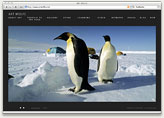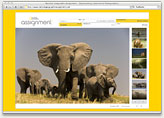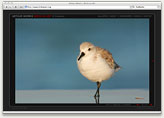BIRDS AS ART BULLETIN #287
MARCH 31, 2009
Visit Arthur Morris / BIRDS AS ART
Please give the images a minute or two to load and do make sure that your security settings are not preventing you from seeing them. Some folks just need to click on “Show (or Allow) Images” on the frame of the e-mail. If you have any trouble at all viewing this Bulletin, you can access it in the Bulletin Archives here: www.birdsasart.com/bn287htm
THE BIRDS AS ART BLOG: GETTING BETTER
SPRING WARBLER CHASE TRIP
BPN IS HOPPING!
TWIP TYPO
LENSES FOR FLIGHT PHOTOGRAPHY
LIVE BOOKS/RESOLVE BLOG INFO
POSSE NEWS/CHRIS DODDS
2009 BEAR BOAT TRIPS
IPT UPDATES
Contact us by phone at 863-692-0906 (Eastern Time Zone) or by e-mail at birdsasart@att.net or birdsasart@verizon.net. The att e-mail address is best from overseas.
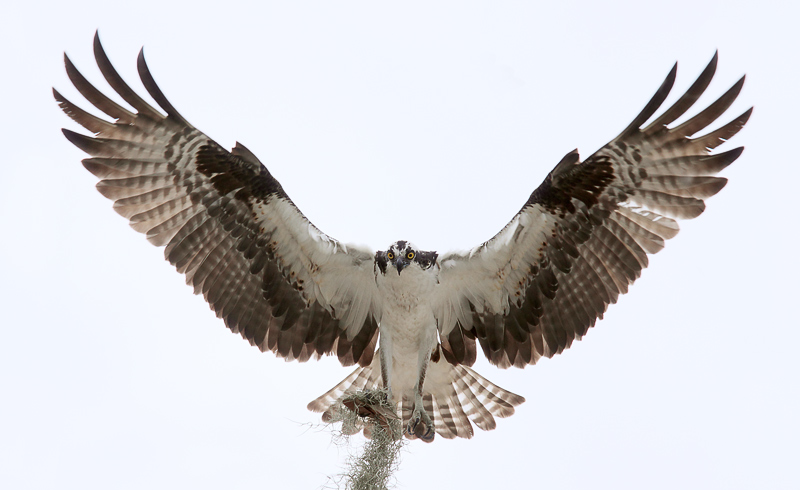
Osprey, landing at nest with dried moss, Indian Lake Estates, FL
Image Copyright 2009: Arthur Morris/BIRDS AS ART
Canon 400mm f/4 IS DO lens (handheld) with the EOS-50D. ISO 800. Evaluative metering +2 stops off the sky: 1/2500 sec. at f/4 in Manual Mode.
Over the past week or so I have been blessed with cloudy afternoons for my health walks. I always have a lens or two on the car seat ready to go when I head down to the lake. There seem to be more pairs of Ospreys than ever before. Though the central sensor only was used to create this image and the sensor was on the birds’ chest, the eyes are beyond razor sharp. I did clip one primary tip and used the Quick Masking techniques detailed in APTATS to replace the missing feather tip. To learn more about APTATS, click here: http://www.birdsasart.com/aptats.htm. The original is below.
I have begun working more with ISO 800 on the 50D and am finding that as long as you expose to the right that the problem is more than manageable.
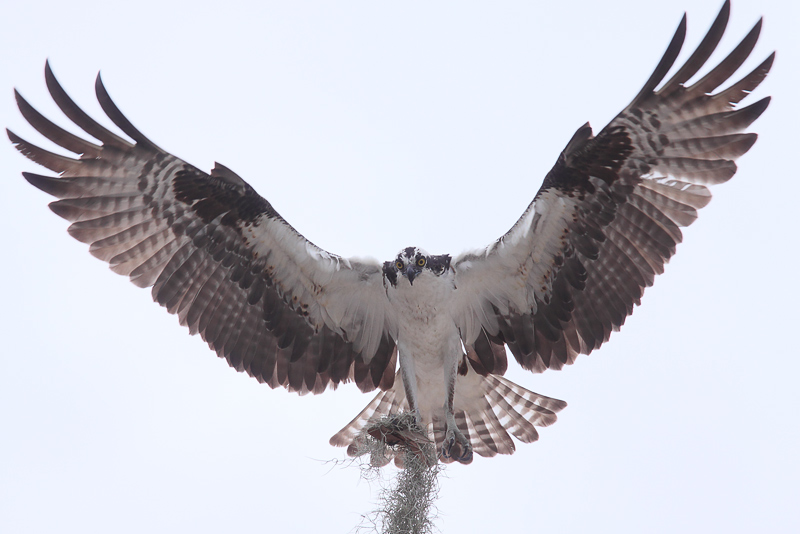
Before adding the wing tip I rotated the image about 7 degrees by running the Ruler Tool through the two pupils and then using Image/Rotate Canvas/Arbitrary. Then I added canvas the fast easy way and did my Levels Adjustment. I used Average Blur Color Balancing to remove the reddish cast from the blacks. All of the techniques mentioned above and tons more are detailed in our Digital Basics File: http://www.birdsasart.com/digitalbasics.htm. Do see the 50D settings entry on the blog to learn how I am trying to solve (or reduce) the 50D red/magenta cast problem with my Picture Style settings: www.birdsasart-blog.com (and scroll down).
THE BIRDS AS ART BLOG: GETTING BETTER
As with any new endeavor, blogging has a learning curve. At first, I had no idea what I was doing. Then, I learned that the images were being distorted by several browsers. We solved that but soon realized that the images were too small. Now, if you click on the image you will see a much larger JPEG that is sized the same as the Bulletin images. I will be working on my taxes soon and then leaving for six weeks (see item next). At some point we will be customizing the blog. For now, we are good to go as I know how to make posts quickly (even from the road) and to get the images upsized so that folks can enjoy them. Life is good. If you have not checked out the BIRDS AS ART Blog, you can do so by clicking here: www.birdsasart-blog.com. Scroll down to explore.
In the March 29 post, in response to popular demand, I share all of my Canon EOS-50D menu and custom function settings. Most include comments and explanations. Other recent posts include the humorous “Captain Froggie and the Alafia Banks; Near Dunking or Near Drowning?” and “Using All Focusing Points for Erratic Flight and Action.” Feel free to leave comments or ask questions on the blog.
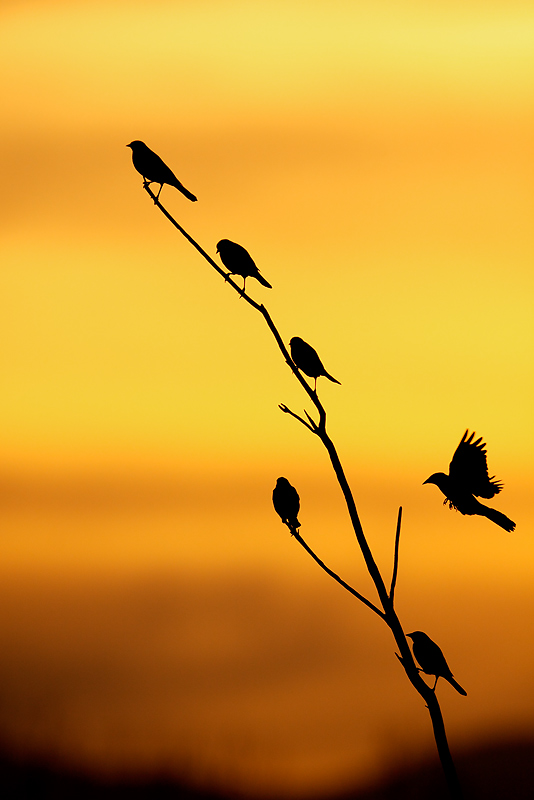
Blackbirds and grackles at sunset, Bosque del Apache NWR, San Antonio, NM
Image Copyright 2009: Arthur Morris/BIRDS AS ART
Canon 800mm f/5.6 L IS lens with the EOS-50D. ISO 400. Evaluative metering +2/3 stop: 1/1600 sec. at f/7.1 in Av mode.
This is a great example of using less plus compensation than normal to avoid over-exposing the red channel. To create images like this, first frame the image and lock the tripod. Then take your eye from the viewfinder, watch for incoming birds, and start pressing the shutter button just before they enter the frame. Sometimes, the very clever get lucky…. <smile>
SPRING WARBLER CHASE TRIP
For years I have dreamed of making a Spring Warbler Chase Trip by SUV. I will be leaving home with my Sequoia packed midday on April 13th and will not be back in the office until the late afternoon of May 26th. I am meeting Chris Dodds in Tampa on the afternoon of the 13th. He is flying from Montreal and will be with me for the first two weeks of the trip. He will fly home from McAllen, TX on May 1 but I will hook up with him again in Point Pelee to co-lead his warbler workshop a week later. (See the Chris Dodds item below). Our first stop will be Dauphin Island, Alabama (April 16 thru 19). Thanks to Chas Mc Rae for the DI tutorial! Next will be Mike Murphy’s Los Madrones ranch in Travis County, TX, April 21-23. Learn more about Los Madrones here: (http://www.losmadrones.com/Los_Madrones/Home.html). Our target bird is Golden-cheeked Warbler, a Hill Country specialty species. Chris and I will spend the next week doing some Texas Valley ranches or chasing migrants on South Padre Island, or both.
After dropping Chris off at the airport I will be spending three or four days at the Cozad Ranch in Linn, TX. Learn more about Johnny Cozad’s great property here: http://www.cozadranch.com/. Early May is prime time for Painted Bunting…. You can check out my Cozad Ranch caracara image by clicking here http://www.birdsasart.com/bn171.htm and scrolling down. It can be great for Crested Caracara and Harris’s Hawk at various seasons. I may or may not spend a day at High Island, TX before making the long drive to Pt. Pelee. I need to be there on the late afternoon of May 7th. After co-leading with Chris at North America’s holy grail warbler location, I will drive over Lake Erie, through Buffalo, NY, and eventually make it to my Mom’s in Holbrook, NY about 60 miles out on Long Island. Then there will be another long drive to Monterey, VA where I will be meeting Dean Newman to photograph nesting Mourning and Golden-winged Warblers in the mountains just east of the VA/WV border. I drive to Lorton, VA on the morning of May 25th, hop on the Auto Train, and arrive in Sanford, FL mid-morning on May 26th. From there it is a 2+ hour drive to my home in Indian Lake Estates. Then I’m home for five full days before flying to Anchorage for Bear Boat #1. You gotta love it. Wish me luck.
If you live anywhere along the route and would like to explore the possibility of spending a day in the field with me, please call or e-mail to inquire about rates, scheduling, and terms.
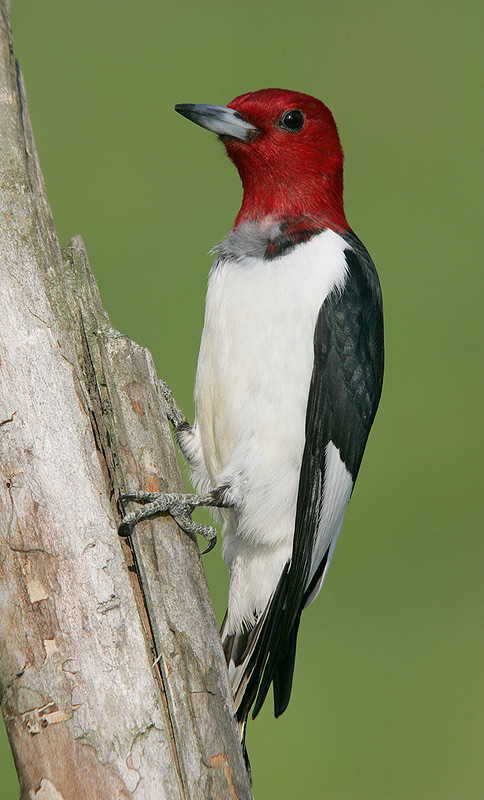
Red-headed Woodpecker, Ontario, Canada
Image Copyright 2004: Arthur Morris/BIRDS AS ART
Canon 500mm f/4 L IS lens with the 1.4X II TC and the EOS-1D Mark II. ISO 250. Evaluative metering +1/3 stop: 1/400 sec. at f/11 set manually after histogram check.
This hard to find species was photographed at a feeder set-up in a park about an hour from Pelee on my last visit to Leamington. I am anxious to get back! To learn how to create feeder set-ups and design a backyard photo/feeder studio, check out the Practicalities Chapter in my CD book, “The Art of Bird Photography II.” Learn more or order here: http://www.birdsasart.com/ABPII.htm. More than 4,200 sold all over the world to rave reviews.
BPN IS HOPPING!
The huge success of Bird Photographers.Net (Honest critiques done gently: www.BirdPhotographers.Net) was not unexpected but none-the-less, it has been gratifying, satisfying, and thrilling. Our crack staff of moderators and owners has been working hard to provide honest critiques done gently. I have been pounding the boards for nearly two weeks now.
Here is a comment made by new member Zenon Char: There is a lot of great info on that thread. Thanks for posting the link. I skimmed through but got the idea. I bookmarked it and will give it a good read. Is there ever a lot of information in the Educational Resources Forum! Wow, what a website this is. My head is starting to swim.
You can find the whole thread here:
http://www.birdphotographers.net/forums/showthread.php?t=32953&goto=newpost
In the same vein, here is an e-mail from Kevin Matthews of Odessa, FL:
Hi Artie, I just wanted to express my sincere thanks to you, not only for your materials but for the very kind and encouraging comments left for me on BirdPhotographers.Net. Frankly, with so many wonderful images posted, I was amazed that you would even bother to comment. Do know that your words have greatly encouraged me to get out and get it right and do it better. Your book and the subsequent volume, ABP II, have become my most used resources. I have read them each at least a dozen times (mainly while flying from coast to coast with work). The information contained in these works is invaluable and I will probably read them both at least a dozen times more. The sections on exposure are particularly invaluable and I have learned more from these pages than in any other book I have read! Studying your images (particularly in the second edition) has enabled me to "set the bar" of what is acceptable and each time I look I am encouraged to go out again and again to do better. In addition, your educational posts on birdphotographers.net are invaluable. Thank you for taking the time to participate as you do. I am sure that I am not alone in being so appreciative of you making the effort to do so. I do hope that at some point in the future that I might bump into you locally and have the chance to say "hello" in person, or have an opportunity to join you on one of your retreats. Best, Kevin
There have been some spirited exchanges of ideas in two recent threads; though opinions differed widely everyone behaved civilly and treated those on the opposite side of the fence with respect. Do check out Supplemental Feeding: Right or Wrong?” here:
http://birdphotographers.net/forums/showthread.php?t=32742
and “Mist Netting & Bird Banding; Right or Wrong?” here:
http://birdphotographers.net/forums/showthread.php?t=33031
Surf the galleries and post an image or two. James Shadle and I are constantly amazed at how few of our workshop participants (and Bulletin subscribers!) take advantage of the amazing educational opportunities available on BPN. Almost as amazing is the cost of a membership: less then 5 ˝ cents per day. Do consider dropping in: www.BirdPhotographers.Net
To see great images and actual learning taking place, visit these two threads:
Ákos Lumnitzer’s “Laughing Pelican,” here: http://birdphotographers.net/forums/showthread.php?t=32951.
and Paul Kusmin/s “Rufous Hummingbird,” here: http://birdphotographers.net/forums/showthread.php?p=233823&highlight=rufus#post233823
I realized while locating these two threads that one of BPN’s great strengths is its worldwide appeal and participation. Ákos is from Australia and Paul from British Columbia.
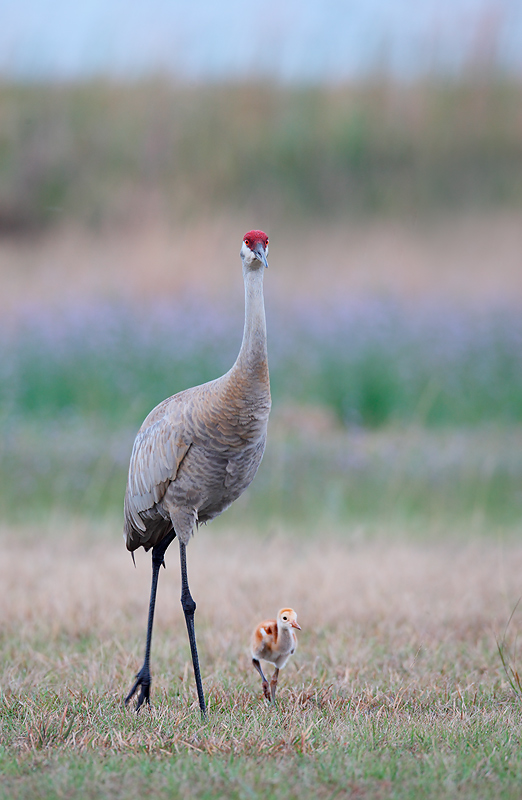
Sandhill Crane with tiny chick & wildlflowers, Indian Lake Estates, FL
Image Copyright 2009: Arthur Morris/BIRDS AS ART
Canon 800mm f/5.6 L IS lens with the EOS-1D MIII. ISO 800. Evaluative metering +1 2/3 stops: 1/80 sec. at f/7.1 in Av mode.
Early spring can be magic at ILE. I was walking the tightrope here trying to balance the ISO and the shutter speed while at the same time getting a bit of extra depth-of-field. It worked! I placed the central AF sensor on the adult’s breast to wind up with a pleasing composition.
TWIP TYPO
The last time that I mentioned my good pal Scott Bourne, there was a typo in the link to his blog. Here is the correct link: http://www.twipphoto.com
LENSES FOR FLIGHT PHOTOGRAPHY
My e-mail exchange with Ed Hutchinson:
AM: Hi Ed, re:
EH: A question just came to mind while looking at one of your bulletins. What do you recommend as a hand-holding birds-in-flight lens?
AM: Most any telephoto can be handheld for flight photography. In the past, I made a very few good flight images with my 600mm f/4, and more recently, with my 800 f/5.6. My very favorite lens for general handheld flight photography is the Canon 400mm f/4 IS DO lens. (Before I fell in love with this lens I used the older Canon 400mm f/5.6L lens. It is still a great flight lens. It is much lighter than the 400 DO, costs a heck of a lot less, but is not an Image Stabilized lens and at f/5.6 is not as fast.) When you are photographing birds at varying distances from your position, the Canon 100-400mm IS L zoom lens is often best. And either the 300 f/4 or the 300 f/2.8 lenses also make excellent flight photography lenses, the latter is the favorite of many of the world's premier hawks-in-flight photographers like Brian K. Wheeler, Ned Harris, and Jim Zipp.
EH: I note that you often use the 70-200mm f/4 with and without the 1.4x II TC.
AM: I use it mostly without the teleconverter and mostly with the Canon EOS-50D and its 1.6X multiplier effect.
EH: In the list I included in my previous email I listed the 70-200mm f/2.8 version of the lens because I have read so many outstanding reviews. For hand-holding do you recommend the f/4 over the f/2.8 because of the weight
difference?
AM: Yes. I love the f/4 for its light weight; it rides easily on my shoulder.
EH: Or, for this purpose is there another lens even better than the 70-200mm?
AM: As I said, many different lenses can be used for photographing birds in flight. Choosing a lens for flight photography depends a lot on the situation: how close will you be to the birds and how large are the birds? In Homer, AK, for example, the 70-200s ruled the roost as the eagles were so, so close. At Bosque for the most part, you need a long lens on a tripod as the birds are usually a good distance away. Though the Canon 400mm f/4 IS DO lens is my favorite lens for general handheld flight photography, I often turn to other tools to get the job done right.
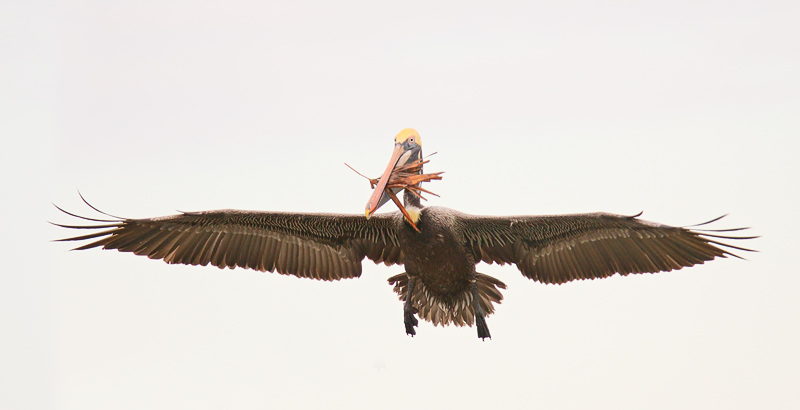
Brown Pelican, Sarasota, FL
Image Copyright 2009: Arthur Morris/BIRDS AS ART
Canon 400mm f/4 IS DO lens handheld with the EOS-50D. ISO 640. Evaluative metering + 1 2 /3 stops off the sky: 1/1000 sec. at f/4 in Manual Mode.
I had the pleasure recently of photographing with multiple IPT-veteran Lou Newman and his friend Ron Mayberry on Ron’s boat. Thanks guys! The key to photographing in the fog is to overexpose a lot and to not delete images when they look lousy on the back of the camera (as this one did). With digital, the color information is there; straightforward processing turns blah to oh- my with ease. To see another image from this foggy morning and learn a cool Gaussian blur trick, click here: http://birdphotographers.net/forums/showthread.php?t=31848&highlight=newman
LIVE BOOKS/RESOLVE BLOG INFO
Click on the Sanderling image to see the BIRDS AS ART Live Books Gallery or follow the various links for some great stuff.
LIVE from the Bering Sea
Host: Chris Linder
In this presentation Chris will be discussing his favorite images from the first four weeks of embedded photojournalism aboard the USCG icebreaker Healy, live via satellite phone.Get a Client and Keep Them: What are You doing to Ensure They Come Back?
Host: Consultants Amanda Sosa Stone & Suzanne SeazeProspecting New Clients
Host: Consultant Ian Summers
How to identify prospects who can give you what you want.Successful Self-Promotion for the Digital Age
Host: Louisa CurtisPerfecting Your Workflow with Lightroom: Catalogs, Archiving and Optimizing
Host: Jared PlattDrive More Business with Your Website!
Host: Dinno Kovic
A New Business Model In the Face of Faltering Stock Sales
By Art WolfeHow to Work With Environmental NGOs
By Garth LenzTransitioning from Advertising to Landscape Photography
By Brian KosoffBy Cristina Mittermeier
The Amazon, Why It Matters,
and a Top Secret New PhotoBy Daniel Beltra
Being a Top Bird Photographer
Requires More Than Great PhotographsBy Arthur Morris
888.833.4605 :: www.liveBooks.com
©2009 liveBooks. 989 Market St., San Francisco, CA 94103. All rights reserved.
POSSE NEWS/CHRIS DODDS
I will be co-leading a Warbler/Songbird Workshop at Point Pelee this spring with Chris Dodds. Join us for warblers, tanagers, orioles, thrushes, woodpeckers, and lots more. We expect both Northern Oriole and even Red-headed Woodpecker. Warbler photography is both challenging and weather-dependent but with two experienced leaders visiting this prime location on the perfect dates, your chances will be maximized.
Pelee Songbirds Workshop, Point Pelee National Park (near Leamington), Ontario, Canada. May 8 to 12, 2009. 5-DAY: $1,695.00 per person CDN. Limit 6; openings: 3.
For complete details and sample images, click here: http://webfarm.foliolink.com/Asset.asp?AssetID=16776&AKey=HKP7BK55
There is room on Monsieur Dodds amazing Gannets Galore workshops this June. The coolest thing about these trips is that you can come a day early, stay a day late, and enjoy five great days of photography. You can see my images from last June here: http://www.birdsasart.com/bn264.htm All of the images in that Bulletin were created on a single five day trip and I wound up entering two of them in the 2009 BBC Wildlife Photographer of the Year Competition.
Gannets Galore/June 7-9, 2009. 3-DAY: CAD$2395.00. Limit: 6/Openings: 5
Gannets Galore/June 11-13, 2009. 3-DAY: CAD$2395.00. Limit: 6/Openings: 2
Gannets Galore/June 15-17, 2009. 3-DAY Leader: Chris Dodds CAD$2395.00. Limit: 6/Openings: 1
Gannets Galore/June 19-21, 2009. Leader: Chris Dodds. 3-DAY: CAD$2395.00. Limit: 6/Openings: 4
You can find the complete details (including travel info and unsolicited testimonials) here: http://webfarm.foliolink.com/Asset.asp?AssetID=13967&AKey=HKP7BK55. To register try Chris at home at 1-450-827-1007 or on his cell: 1- 514-945-6195. Be sure to leave a message if there is no answer and follow that up with an e-mail to chris@chrisdoddsphoto.com.
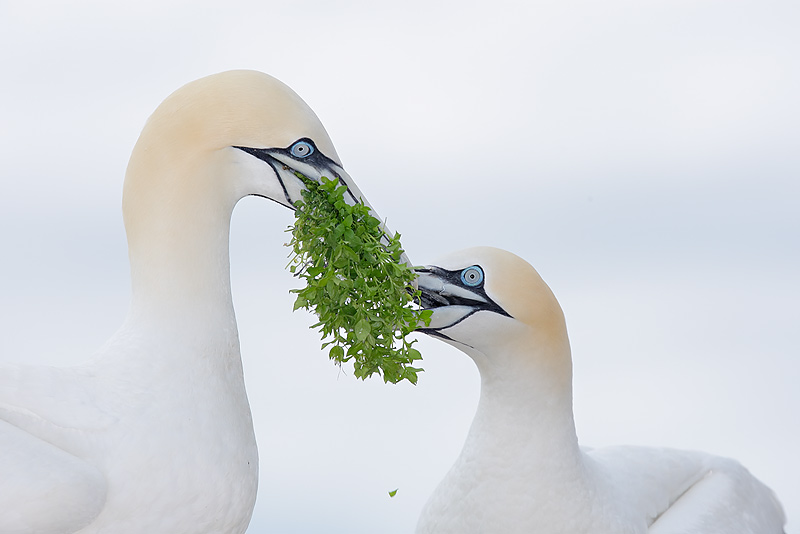
Northern Gannet pair, nesting material exchange, Bonaventure Island, Quebec
Image Copyright 2008: Arthur Morris/BIRDS AS ART
Canon 400mm f/4 IS DO lens and the EOS-1D Mark III. ISO 400. Evaluative metering +1 2/3 stops off the sky set manually: 1/800 sec. at f/4. Fill flash at +1 stop with Better Beamer. Mongoose M3.5 on the Gitzo 3530 LS tripod with the Mongoose Integrated Flash Arm.
With the white skies I used lots of flash to make the whites really white. I used 45-point AAFPS to hold focus. Join Chris or Chris and me in Gaspe this June.
2009 BEAR BOAT TRIPS
Who has not dreamed of photographing the coastal grizzlies at close range as they go about their daily business? If you are at all interested in joining me for the trip of a lifetime, please e-mail (birdsasart@att.net) or call me at 863-692-0906.
Do check out the brand new Katmai Bear Boat Gallery here: www.birdsasart.com/katmaibearboatgallery. If you do not think that you can make this trip, it would be best not to look at the gallery….
Be
Be
If you are curious about either of the bear trips or have any questions and would like to explore the possibility of joining me for the trip of a lifetime, please e-mail (birdsasart@att.net) or call me at 863-692-0906. I will do my very best to make it happen.
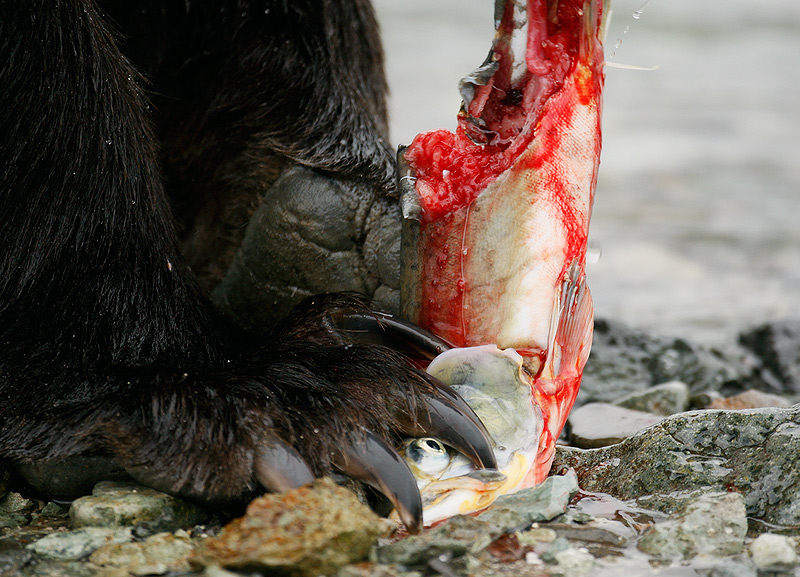
Coastal Brown Bear with pink (humpback) salmon, Katmai National Park, AK
Image Copyright 2008: Arthur Morris/BIRDS AS ART
Canon 500mm f/4L IS lens with the EOS-Mark III. ISO 800. Evaluative metering +1 2/3 stops off the river: 1/320 sec. at f/4 set manually.
As this was my fifth trip to photograph coastal Brown Bear, the challenge for me was to create some new and different images. When this bear caught a fish, walked directly towards me, and stopped 23 feet four inches away to consume its prey, I had my chance to create a unique image. At 650mm effective focal length I was so close that at first I was confused as to what to do. I was working in horizontal format so when I noticed the eye of the pink salmon peeking through the bear's claws. I selected the lower-most sensor and made a few images before switching to VERT format. To learn about how and why I metered as I did, and to read my comments on in-camera meters and digital exposure, check out the BPN thread here: http://birdphotographers.net/forums/showthread.php?p=142371#post142371
IPT UPDATES
I will be teaching fewer and fewer IPTs each year. If you want to learn from the very best, do consider signing up ASAP.
Bosque 2009 IPT:
NEW:
SW FLA PRESIDENT'S DAY IPT:

White Ibis flock at dawn, Alafia Banks, Tampa, FL aboard the Hooptie Deux with James Shadle
Image Copyright 2008: Arthur Morris/BIRDS AS ART
Canon 800mm f/5.6L IS lens with the EOS-1D Mark III. ISO 1000: 1/60 sec. at f/5.6.
When you are confronted with a great situation, look to vary your focal length and your mental approach to image making. Below you will find several vastly different images from that same morning. The image above is a two-frame stitched pano created at 7:33 am.

Canon 70-200mm f/4L IS lens (handheld at 121mm) with the EOS-1D Mark III. ISO 640: 1/60 sec. at f/5.6.
Above is four-frame stitched pano that was created at 7:39 am as we approached the flock slowly.
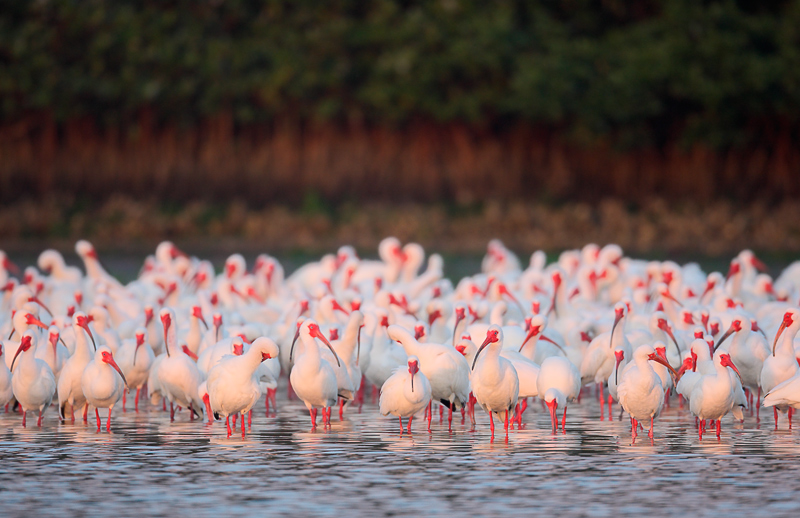
Canon 800mm f/5.6L IS lens with the EOS-1D Mark III. ISO 800. Evaluative metering +1/3 stop: 1/125 sec. at f/5.6. Mongoose M3.5 atop the Gitzo 3530 LS.
The image above was created at 7:42:01 am just minutes after the sun cracked the horizon.
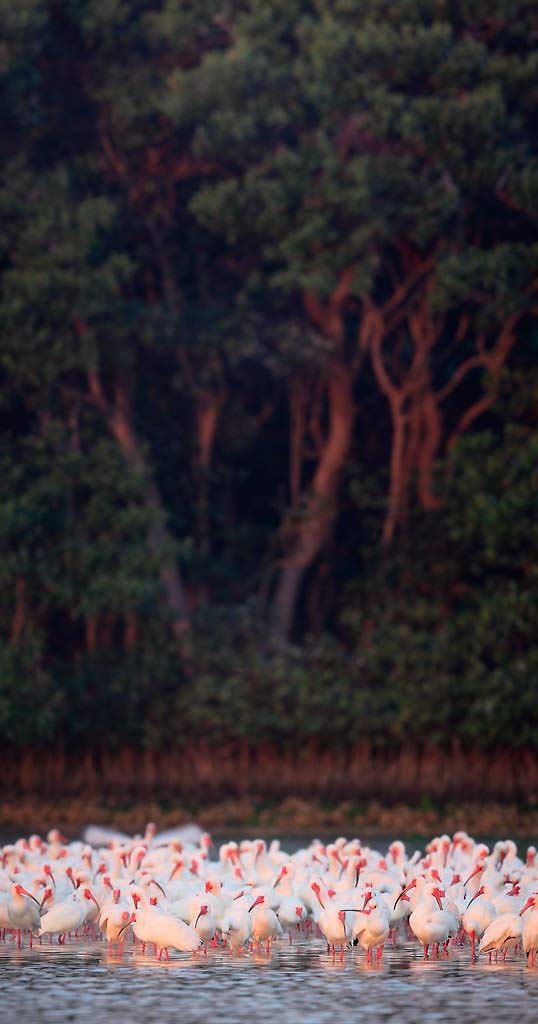
Canon 800mm f/5.6L IS lens with the EOS-1D Mark III. ISO 800: 1/100 sec. at f/5.6.
Above is a three-frame stitched vertical pano. I created this one to feature the soft light on the trunks of the red mangroves as well as the ibis flock. I began creating the images for this pano at 7:42:29 am, less than 30 seconds after making the image above. When conditions are good you need to think and work fast in order to maximize your results.
Best and love and great picture-
